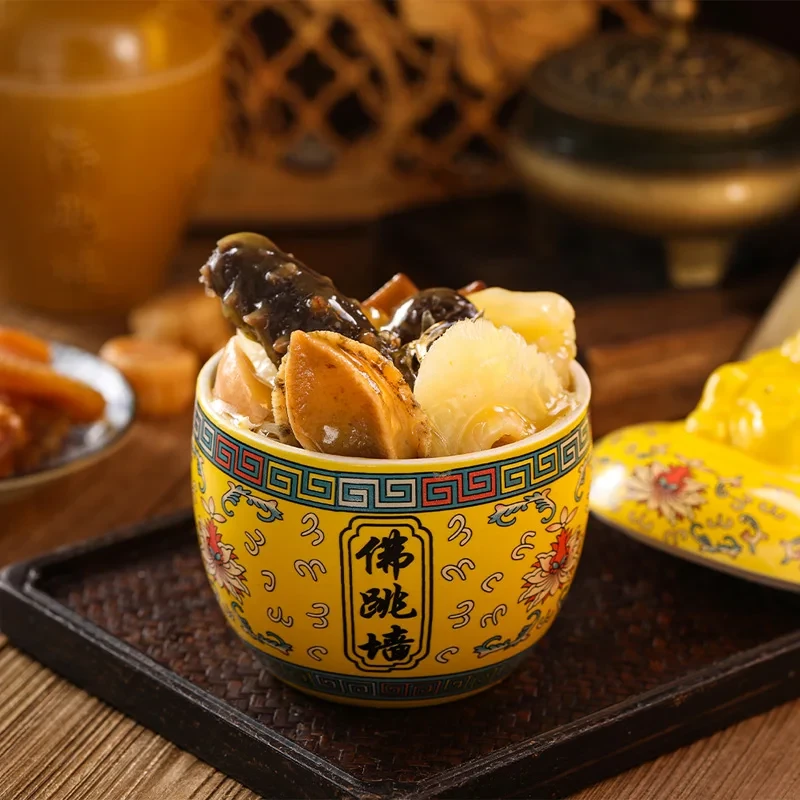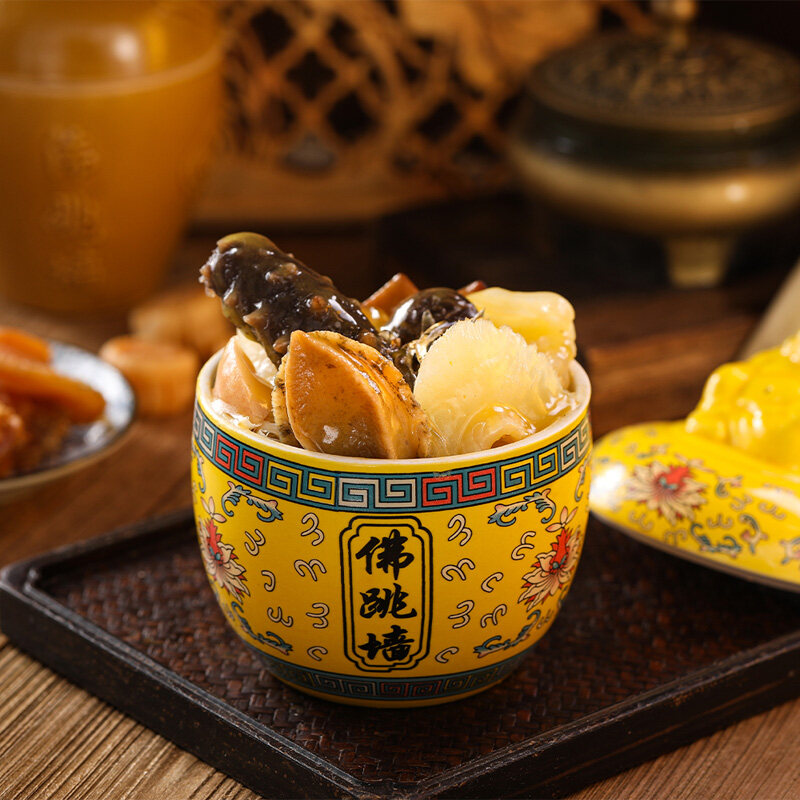Email cannot be empty
Password cannot be empty
Email format error
Email cannot be empty
Email already exists
6-20 characters(letters plus numbers only)
The password is inconsistent
Email format error
Email cannot be empty
Email does not exist
6-20 characters(letters plus numbers only)
The password is inconsistent


The Art of Crafting an Authentic Buddha Jump Over the Wall Recipe
Introduction: The History and Legend of Buddha Jump Over the Wall
Buddha Jump Over the Wall, also known as “佛跳墙” (Fó Tiào Qiáng), is not just a dish; it’s an experience steeped in history, culture, and legend. Originating from the Fujian province in China, this luxurious and complex soup is a testament to the intricacies of Chinese culinary traditions. The name itself evokes curiosity and wonder. Why would a dish have such a whimsical name? According to legend, the dish was so aromatic and enticing that even a vegetarian monk, upon smelling it, jumped over the wall of his monastery to taste it. Thus, the dish was christened “Buddha Jump Over the Wall.”
This dish is famous not only for its rich flavors but also for the meticulous preparation that goes into crafting an authentic Buddha Jump Over the Wall recipe. It’s a dish that combines the finest ingredients—abalone, sea cucumber, shark fin, fish maw, scallops, and various other delicacies—into a single, flavorful broth. Each ingredient is chosen for its unique contribution to the overall taste and texture of the dish, and together, they create a harmony of flavors that is unmatched.
In this blog, we will dive deep into the art of crafting an authentic Buddha Jump Over the Wall recipe. From selecting the finest ingredients to the step-by-step process of cooking, we will explore what makes this dish so special and how you can recreate it in your kitchen.
The Ingredients: Selecting the Finest Delicacies
One of the key aspects of preparing an authentic Buddha Jump Over the Wall recipe is the careful selection of ingredients. This dish is a celebration of luxury, and the ingredients reflect that. Each component of the dish adds a unique flavor and texture, contributing to the overall complexity of the soup.
1. Abalone:
Abalone is one of the most prized ingredients in this dish. Known for its delicate flavor and chewy texture, abalone is often considered the star of Buddha Jump Over the Wall. When selecting abalone, it’s important to choose high-quality dried abalone and rehydrate it properly before cooking.
2. Sea Cucumber:
Sea cucumber adds a unique texture to the soup, with its slightly gelatinous consistency. It’s also rich in nutrients, making it a popular choice in many Chinese medicinal dishes. Like abalone, dried sea cucumber needs to be soaked and softened before cooking.
3. Shark Fin:
Shark fin has traditionally been used in this dish for its texture, which is slightly crunchy yet tender. However, due to ethical concerns, many modern recipes substitute shark fin with alternatives like gelatin or other seafood that mimic its texture.
4. Fish Maw:
Fish maw, the swim bladder of a fish, is another ingredient that adds both texture and nutritional value. It’s rich in collagen and has a subtle flavor that absorbs the taste of the broth.
5. Scallops:
Dried scallops, or “conpoy,” are used to add a deep umami flavor to the soup. They should be soaked before cooking to rehydrate and release their full flavor.
6. Chinese Ham:
Chinese ham, often from Jinhua, is used to add a savory depth to the broth. The ham is typically simmered with the other ingredients to infuse the soup with its rich, smoky flavor.
7. Mushrooms:
Dried shiitake mushrooms are a common addition to Buddha Jump Over the Wall. They add an earthy flavor and meaty texture to the soup.
8. Ginseng:
Ginseng is often included for its medicinal properties and slightly bitter flavor, which balances the richness of the other ingredients.
9. Goji Berries:
Goji berries add a hint of sweetness and a pop of color to the dish. They are also valued for their health benefits.
10. Chicken and Pork:
These are used as the base for the broth, providing a rich, flavorful foundation for the other ingredients.
The Preparation: A Labor of Love
Creating an authentic Buddha Jump Over the Wall recipe is no small feat. It requires time, patience, and a deep respect for the ingredients. Each component must be prepared with care to ensure that the final dish is a harmonious blend of flavors and textures.
1. Rehydrating and Preparing the Ingredients:
The first step in preparing Buddha Jump Over the Wall is to rehydrate and prep the dried ingredients. This includes soaking the abalone, sea cucumber, fish maw, and scallops in water for several hours or overnight. The soaking process not only softens the ingredients but also allows them to expand and release their natural flavors.
2. Preparing the Broth:
The broth is the heart of Buddha Jump Over the Wall. It is typically made by simmering chicken, pork, and Chinese ham with aromatics such as ginger and green onions. The broth should be cooked slowly over low heat to extract as much flavor as possible. Once the broth is ready, it is strained to remove any impurities and to create a clear, rich base for the soup.
3. Assembling the Ingredients:
Once all the ingredients are prepped and the broth is ready, it’s time to assemble the dish. The rehydrated ingredients are layered in a clay pot or a specially designed porcelain jar. The order of layering is important, as it ensures that each ingredient is cooked to perfection and that the flavors meld together harmoniously.
4. Cooking the Dish:
The assembled pot is then filled with the prepared broth and sealed with a lid or parchment paper. The dish is cooked slowly over low heat, often for several hours, allowing the flavors to fully develop. This slow-cooking process is what gives Buddha Jump Over the Wall its signature richness and depth of flavor.
The Experience: Savoring the Flavors
Buddha Jump Over the Wall is not just a dish; it’s an experience that engages all the senses. The aroma that wafts through the air as the dish cooks is enough to make anyone’s mouth water. The first sip of the broth reveals a complex interplay of flavors—savory, umami, slightly sweet, and deeply satisfying. The texture of the ingredients, from the tender abalone to the chewy sea cucumber, provides a delightful contrast that keeps each bite interesting.
This dish is often reserved for special occasions, and it’s easy to see why. The time and effort that go into preparing an authentic Buddha Jump Over the Wall recipe make it a labor of love, and the result is a dish that is truly unforgettable.
Variations and Modern Interpretations
While the traditional recipe for Buddha Jump Over the Wall is steeped in history, modern chefs have put their own spin on the dish, creating variations that cater to different tastes and dietary preferences. Some variations include:
1. Vegetarian Buddha Jump Over the Wall:
For those who prefer a vegetarian or vegan diet, there are versions of Buddha Jump Over the Wall that use plant-based ingredients. Instead of abalone and sea cucumber, these recipes might include tofu, mushrooms, and other plant-based proteins. The broth is made using a vegetable stock, often enriched with ingredients like miso or soy sauce to add depth.
2. Simplified Buddha Jump Over the Wall:
Given the complexity of the traditional recipe, some home cooks prefer a simplified version that uses fewer ingredients but still captures the essence of the dish. For example, instead of using dried abalone and sea cucumber, fresh or canned versions might be used, which require less preparation time.
3. Fusion Buddha Jump Over the Wall:
In some modern restaurants, chefs have experimented with incorporating elements from other cuisines into Buddha Jump Over the Wall. This might include adding ingredients like truffle oil for an earthy aroma or using a different type of seafood to create new flavor combinations.
Tips for Cooking Buddha Jump Over the Wall at Home
Cooking Buddha Jump Over the Wall at home can seem intimidating, but with the right approach, it’s a rewarding experience. Here are some tips to help you master this dish:
1. Plan Ahead:
This dish requires a lot of preparation, so it’s important to plan ahead. Start soaking your dried ingredients a day before you plan to cook, and make sure you have all the necessary ingredients on hand.
2. Invest in Quality Ingredients:
The quality of the ingredients is crucial in this dish. Since Buddha Jump Over the Wall is a celebration of luxury, it’s worth investing in high-quality abalone, sea cucumber, and other delicacies.
3. Be Patient:
This is not a dish to rush. The slow-cooking process is essential to developing the rich, complex flavors that Buddha Jump Over the Wall is known for. Take your time, and enjoy the process.
4. Experiment with Variations:
Don’t be afraid to put your own spin on the dish. Whether it’s incorporating different ingredients or adjusting the seasoning to suit your taste, feel free to experiment and make the dish your own.
Conclusion: A Culinary Masterpiece
Buddha Jump Over the Wall is more than just a recipe; it’s a culinary masterpiece that reflects the richness of Chinese culture and history. The authentic Buddha Jump Over the Wall recipe is a testament to the artistry of Chinese cooking, where each ingredient is carefully selected and prepared to create a dish that is both luxurious and deeply satisfying.
Whether you’re preparing it for a special occasion or simply want to challenge yourself in the kitchen, crafting an authentic Buddha Jump Over the Wall recipe is an experience that is sure to leave a lasting impression. The complexity of the flavors, the variety of textures, and the sheer indulgence of the ingredients make this dish a true celebration of Chinese culinary.

